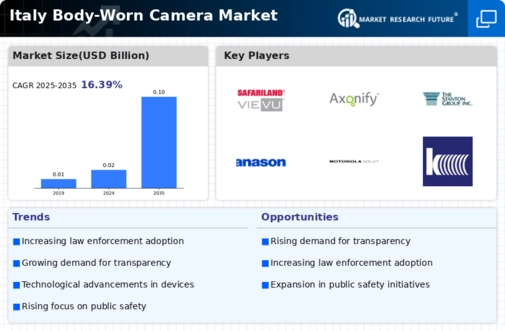The body worn-camera market in Italy is characterized by a dynamic competitive landscape, driven by technological advancements and increasing demand for accountability in law enforcement. Key players such as Axon (US), Motorola Solutions (US), and Panasonic (JP) are at the forefront, each adopting distinct strategies to enhance their market presence. Axon (US) focuses on innovation through continuous product development, emphasizing integrated software solutions that complement their hardware offerings. Meanwhile, Motorola Solutions (US) leverages its extensive experience in communication technologies to provide comprehensive solutions that include body worn cameras as part of a broader security ecosystem. Panasonic (JP) appears to be concentrating on regional expansion, aiming to strengthen its foothold in Europe by tailoring its products to meet local regulatory requirements and user preferences.
The competitive structure of the market is moderately fragmented, with several players vying for market share. Key business tactics include localizing manufacturing to reduce costs and optimize supply chains, which is particularly relevant in the context of rising global logistics challenges. The collective influence of these major players shapes a competitive environment where innovation and operational efficiency are paramount, allowing them to respond swiftly to market demands.
In October 2025, Axon (US) announced a strategic partnership with a leading Italian technology firm to enhance its software capabilities, indicating a strong commitment to integrating advanced analytics into its body worn-camera systems. This move is likely to bolster Axon's competitive edge by providing law enforcement agencies with enhanced data-driven insights, thereby improving operational efficiency and accountability. The partnership underscores the importance of collaboration in driving technological advancements within the sector.
In September 2025, Motorola Solutions (US) launched a new line of body worn cameras equipped with AI-driven features designed to improve video quality and data management. This innovation not only positions Motorola as a leader in technological integration but also reflects a broader trend towards incorporating artificial intelligence in security solutions. The introduction of these advanced features may attract a wider customer base, particularly among agencies seeking to enhance their operational capabilities.
In August 2025, Panasonic (JP) expanded its product line to include environmentally sustainable body worn cameras, aligning with global trends towards sustainability. This strategic move not only addresses growing environmental concerns but also positions Panasonic favorably among eco-conscious consumers and organizations. By prioritizing sustainability, Panasonic may differentiate itself in a crowded market, appealing to clients who value corporate responsibility.
As of November 2025, the body worn-camera market is increasingly defined by trends such as digitalization, AI integration, and sustainability. Strategic alliances are becoming more prevalent, as companies recognize the need to collaborate to enhance their technological offerings. Looking ahead, competitive differentiation is likely to evolve from traditional price-based competition to a focus on innovation, technology integration, and supply chain reliability. This shift suggests that companies that prioritize these aspects will be better positioned to thrive in an increasingly competitive landscape.























Leave a Comment